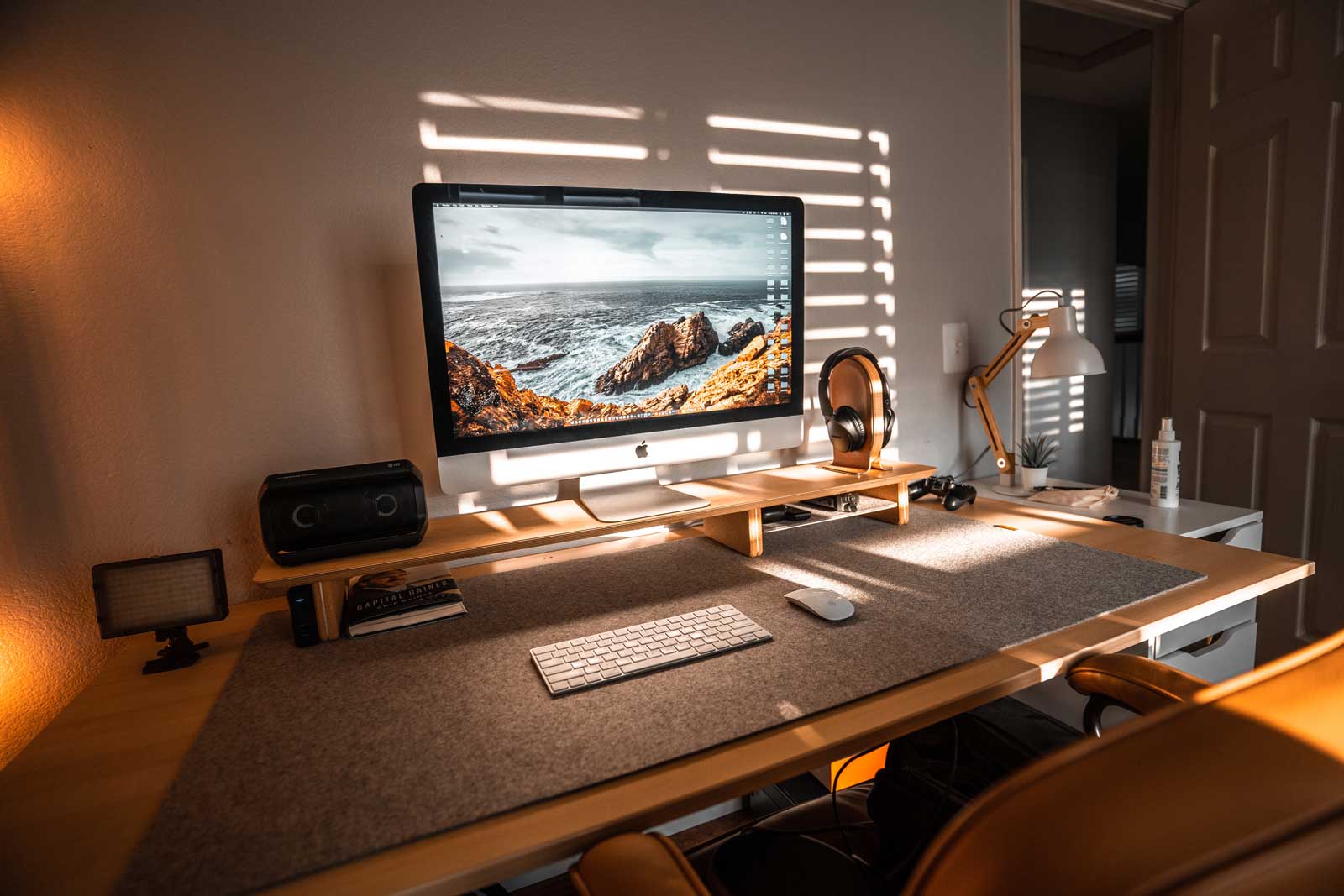Your home office chair groans under the weight of yet another extended workday; the clock ticks past 6 PM, but the laptop screen still glows fiercely.
What ever happend to that promise of flexibility that remote work boasted?
What about the time for hobbies, for self-care, for the family that seems to be just another tab minimized on your browser?
And what about the psychological toll of living at work, rather than working from home?
How do we draw the line when the tools of our trade are a mere arm’s length away at all hours?
This is the silent struggle of the modern professional, the untold story of remote work’s challenge to our work-life balance. In this post we’re going to dig into the strategies to separate the professional from the personal, ensuring your home doesn’t morph into a 24/7 workstation.
The Blurred Lines of Home and Office

Working from home might sound like a dream, but step in and you’ll quickly find that separating work and personal life turns out to be quite the challenge. In this section, we’ll dive into the core issue you face when attempting to find that perfect balance. So, let’s explore the new normal and the psychological impact of space overlap.
The New Normal: Introducing WFH’s Core Challenge
By now, you’ve probably adjusted to remote work and are well aware of the obstacles it presents. But did you know one of the most fundamental challenges of working from home revolves around the blurred lines between your office and personal life? You may have found commuting to the office was your way of setting boundaries. A physical office space provided a clear distinction between your working hours and personal time, a luxury that’s become increasingly scarce when working from home.
Space Overlap: The Psychological Impact
Your workspace in the living room or bedroom might feel convenient, but it can lead to a significant overlap between your work and personal life. This overlap can make it difficult for you to separate the two, leading to a psychological impact on your well-being.
When your work desk is a few steps away from the couch where you relax, your brain constantly associates both spaces with both work and relaxation, making it harder to disconnect and unwind. If you’re not careful, your work schedule might start to bleed into your evenings and weekends, never truly leaving your plate full of obligations.
To prevent these issues and maintain a healthy work-life balance:
- Create a dedicated workspace separate from your living area.
- Set specific working hours and stick to them, just like commuting to an office.
- Communicate your boundaries with family members and colleagues.
Navigating the blurred lines between home and office is essential to maintaining productivity, motivation, and work-life balance. By recognizing and addressing the challenges, you’ll be better equipped to tackle your new normal in the world of remote work. In the next section, let’s dive into some practical tips to help you create that perfect balance.
Clocking Out Is Harder at Home

“Clocking out” takes on a new meaning when working from home. You might find yourself working longer hours or struggling to create a clear separation between work and personal life. Let’s dive into how this challenge presents itself and what you can do to overcome it.
Extended Hours: Work’s Encroachment on Personal Time
The transition to working from home can blur the lines between work and personal life. You may find yourself working longer hours as the boundaries start to fade. This can lead to burnout and a lack of time for essential self-care activities such as exercise, relaxation, and spending quality time with loved ones.
To prevent work from encroaching on your personal time, set clear boundaries. Create a separate workspace, establish routines, and commit to regular breaks. This can help you maintain a healthy work-life balance and protect your well-being.
Schedule Discipline: Importance of Defined Work Hours
A lack of schedule discipline can compound the difficulties of separating work and personal life. Without set work hours, your personal time may suffer, leaving you feeling overwhelmed and exhausted.
Establishing a daily routine will help you regain control and create a clear distinction between work and personal time. Start by setting consistent work hours and communicate these boundaries to colleagues and family members. Allocate time for healthy habits such as exercise, hobbies, and social connections. By following a balanced routine, you’ll protect your well-being and avoid burnout.
Reclaiming your personal time while working from home isn’t always easy. However, by setting boundaries, maintaining a consistent routine, and prioritizing self-care, you can achieve a satisfying work-life balance.
Always On: The Tech Tether

In our digital age, it’s becoming increasingly difficult to separate work and personal life. Juggling multiple communication channels and staying connected 24/7 can make it feel like you’re always on call. But fear not, we’re here to help you navigate the challenges of working from home and establish healthier tech boundaries.
Connectivity’s Edge: Technology’s Role in Work-Life Balance
In the world of remote work, technology plays both the role of a hero and a villain. On one hand, tools like email, virtual meeting platforms, and team collaboration apps help you stay on top of your work and connect with colleagues. On the other hand, the same technology can make you feel tethered to your job, always reachable, and unable to unplug.
The challenge lies in striking the right balance between staying connected and maintaining boundaries between your work and personal life. When your mobile phone serves as both your work device and gateway to your personal world, it’s easy to get caught up in constantly checking work emails or messages, even during off-hours.
Tech Boundaries: Managing Digital Life for Separation
Creating a healthy work-life balance in the age of remote work requires you to set clear tech boundaries. Here are some ways to do just that:
- Designate devices or apps: Assign specific devices or apps for work and personal use to minimize cross-contamination between the two worlds. For example, use separate email accounts for work and personal communications, and dedicate your work laptop for work activities.
- Establish a work schedule: Set strict work hours and stick to them to create a clear distinction between work and personal time. Communicate your schedule with your colleagues and gently remind them of your boundaries when necessary.
- Create physical boundaries: If possible, set a designated workspace at home and avoid using it for personal activities. This can help maintain a boundary between your work and personal life, acting as a reminder to switch off when the workday is over.
By implementing these strategies, you’ll be better equipped to maintain a healthy work-life balance and thrive in a remote work environment. Your mental well-being and personal relationships will thank you for the effort. And remember, it’s never too late to start embracing healthier digital habits and strong tech boundaries.
Creating Boundaries Within Four Walls

Working from home can be a double-edged sword. On one hand, it offers flexibility and convenience, but on the other, it can be challenging to separate work and personal life. In this section, we’ll explore strategies to help you create boundaries within your home and maintain a healthy work-life balance.
Workspace Design: Setting up for Separation
A well-designed workspace is crucial for maintaining focus and minimizing distractions. To separate your work and personal life, designate a specific area for work within your home. This could be a spare room, a corner in the living room, or even a small desk in the bedroom. Ensure that your workspace is comfortable, well-lit, and free from distractions.
- Invest in ergonomic furniture to support your health
- Keep essential work-only items within reach and avoid clutter
- Personalize your space with motivational quotes, plants, or art
Maintain boundaries by respecting your workspace. Avoid using it for non-work-related tasks and encourage family members to respect this boundary as well.
Mental Shifts: Transitioning Between Roles
Mentally separating work and personal life is just as important as setting up a physical boundary. Establish rituals and routines to help you transition between roles and achieve a better work-life balance.
- Start and end your workday with a routine: This might include preparing a cup of coffee, meditation, or reviewing your schedule
- Set boundaries with remote work: Establish realistic work hours and avoid checking emails or taking work calls beyond those hours
- Take regular breaks: Step away from your workspace and engage in activities that help relieve stress and promote mental health
Remember, maintaining healthy boundaries requires constant effort, communication, and adjustment. By implementing these strategies, you can successfully separate your work and personal life within your home, leading to a happier, healthier, and more balanced life.
Balancing Act in the WFH Era

Are you struggling to maintain a healthy work-life balance while working remotely? If so, you’re not alone. Many employees face this challenge, resulting in decreased productivity and potential burnout. Let’s examine the importance of separating work and personal life and explore practical steps you can take to achieve balance in the work-from-home (WFH) era.
Vital Balance: The Importance of Separation
Remote workers often experience difficulties in dividing their professional and personal responsibilities. This lack of separation can lead to increased stress, anxiety, and eventually, mental health issues. When you’re unable to effectively draw a line between work and personal life, maintaining your work-life balance becomes an uphill battle.
A healthy work-life balance is critical for ensuring overall well-being and job satisfaction. Employees who can successfully juggle their professional and personal lives tend to be more productive and less susceptible to burnout. Don’t underestimate the importance of this balance—it’s crucial for both your mental health and success as a remote worker.
Action Steps: Encouraging Practical Application
To promote a healthy balance between your work and personal life, consider implementing the following strategies:
- Create a dedicated workspace: Having a separate environment for work will help signal your brain when it’s time to focus on professional tasks and when to switch off for the day.
- Set work hours: Establish a routine by setting specific working hours, helping you avoid the temptation to work around the clock. Stick to these hours as much as possible.
- Schedule breaks: Regular breaks during your workday can prevent fatigue and enhance your overall efficiency. Use this time to stretch, take a short walk, or engage in other activities unrelated to work.
- Communicate with your team: Keep your colleagues informed about your availability and working hours to prevent unnecessary intrusions in your personal life.
- Prioritize self-care: Make time for regular exercise, healthy meals, and hobbies. These activities can significantly contribute to managing stress and fostering a well-rounded life.
Telework might offer flexibility and other benefits, but challenges related to work-life balance still persist. By taking a proactive approach and employing the strategies mentioned above, you can navigate the WFH era, creating a healthy balance between your professional and personal life. Remember, finding equilibrium is essential for achieving sustained success and peace of mind in today’s remote work environment.
The Impact of Work From Home on Work-Life Balance and Job Satisfaction
Work From Home and Its Influence on Work-Life Balance
In the study “The Impact of Work From Home on Work-Life Balance and Job Satisfaction”[1], the focus is on the intricate balance between professional duties and personal life when working remotely. The research highlights how the flexibility of working from home can blur the lines between work and personal time, leading to challenges in maintaining a clear separation. This lack of separation can result in increased stress and decreased job satisfaction, emphasizing the need for structured work-from-home policies that support a healthy work-life balance.
Work-Life Balance During COVID-19
Remote Work During the Pandemic: A Test of Work-Life Balance
The article “Work-Life Balance During COVID-19: An Assessment of Work From Home”[2] examines the sudden shift to remote work due to the pandemic and its subsequent effects on work-life balance. The study suggests that while remote work has the potential to offer a better balance, the extraordinary circumstances of the pandemic, including the lack of preparedness for such a transition, exacerbated the difficulty in separating work from personal life. It points out the necessity for organizations to implement supportive measures that can mitigate the challenges faced by employees working from home.
Analyzing Work-From-Home Dynamics
Working From Home: Satisfaction and Work-Life Balance
In the research titled “Working from home, job satisfaction and work–life balance – robust or heterogeneous links?”[3] The authors dig into the complex dynamics of job satisfaction and work-life balance in a remote work setting. The study uncovers that while remote work offers some flexibility, it does not unequivocally lead to higher job satisfaction, and in many cases, negatively affects work-life balance. This underscores the importance of considering individual differences and job characteristics when evaluating the impact of work from home on employees’ lives.
Work From Home and Job Satisfaction Mediated by Work-Life Balance
The Mediating Role of Work-Life Balance Between Work From Home and Job Satisfaction
“Peran mediasi work life balance di antara work from home dan kepuasan kerja”[4] explores the mediating effect of work-life balance on the relationship between working from home and job satisfaction. The findings indicate that a well-managed work-from-home arrangement can positively influence work-life balance, which in turn enhances job satisfaction. However, the study also points out that without proper management and support, the overlap of work and personal life can lead to dissatisfaction, highlighting the critical role of organizational support in remote work scenarios.
Lessons From the Pandemic for HRD Practitioners
Remote Work and Work-Life Balance: Pandemic Lessons for HRD Practitioners
The study “Remote work and work-life balance: Lessons learned from the covid-19 pandemic and suggestions for HRD practitioners”[5] provides valuable insights for Human Resource Development (HRD) practitioners on managing work-life balance in the context of remote work. It identifies the discrepancies between the idealized flexibility of remote work and the actual challenges faced during the pandemic, such as increased work intensity and space limitations. The research emphasizes the role of HRD in helping employees align their work-life balance expectations with reality, suggesting that tailored support and resources are essential for navigating the complexities of remote work.
Resources
- https://www.rsisinternational.org/journals/ijriss/Digital-Library/volume-6-issue-8/641-646.pdf
- https://ijrpr.com/uploads/V3ISSUE11/IJRPR7985.pdf
- https://www.emerald.com/insight/content/doi/10.1108/IJM-10-2019-0458/full/html
- https://ejournal.unikama.ac.id/index.php/mbr/article/view/7026
- https://www.tandfonline.com/doi/full/10.1080/13678868.2022.2047380
